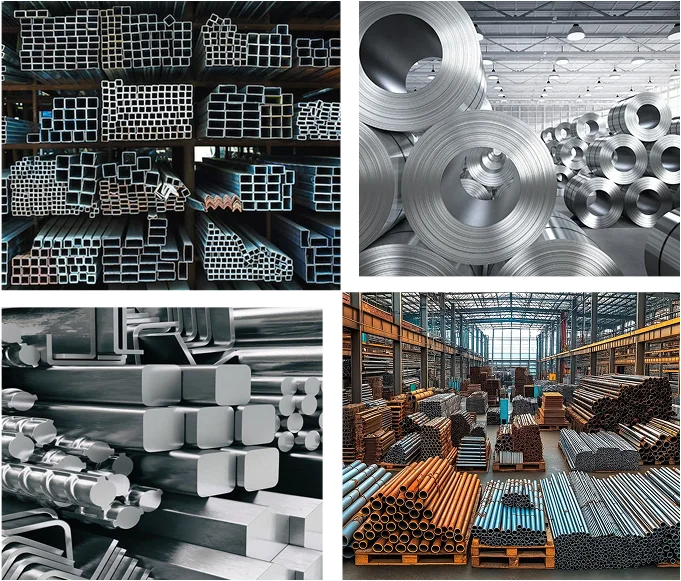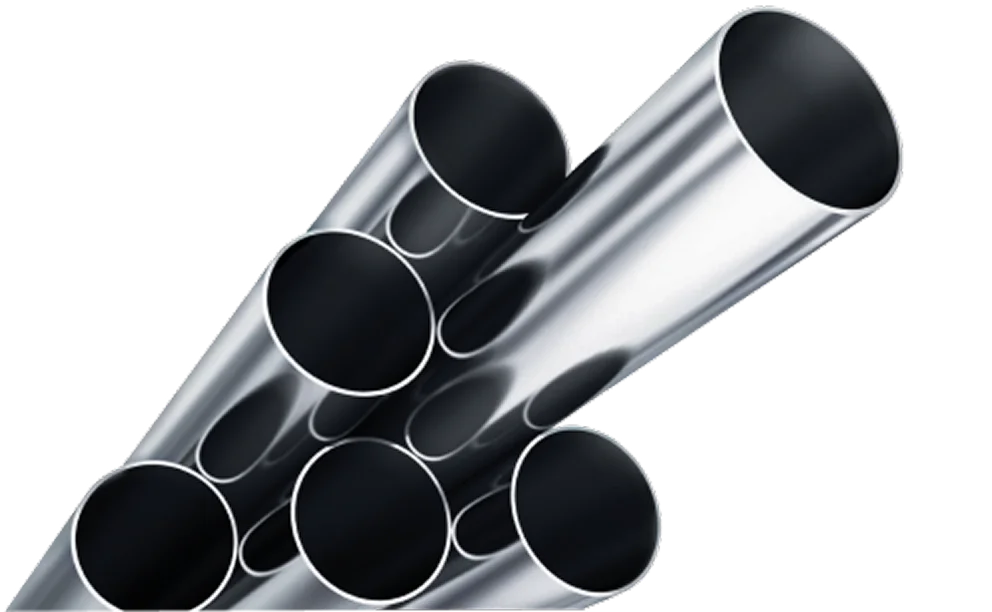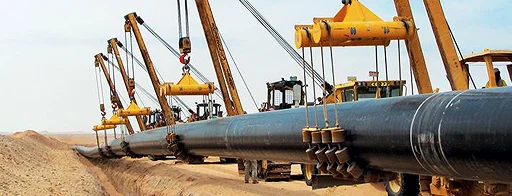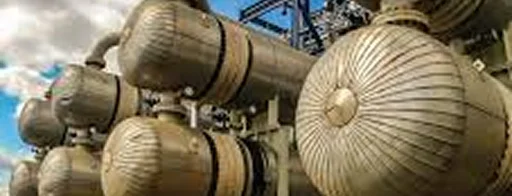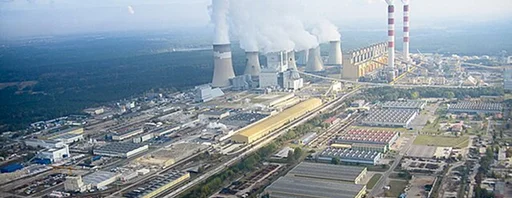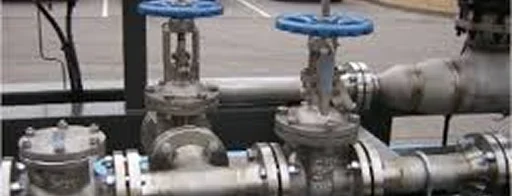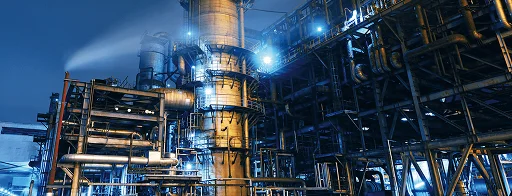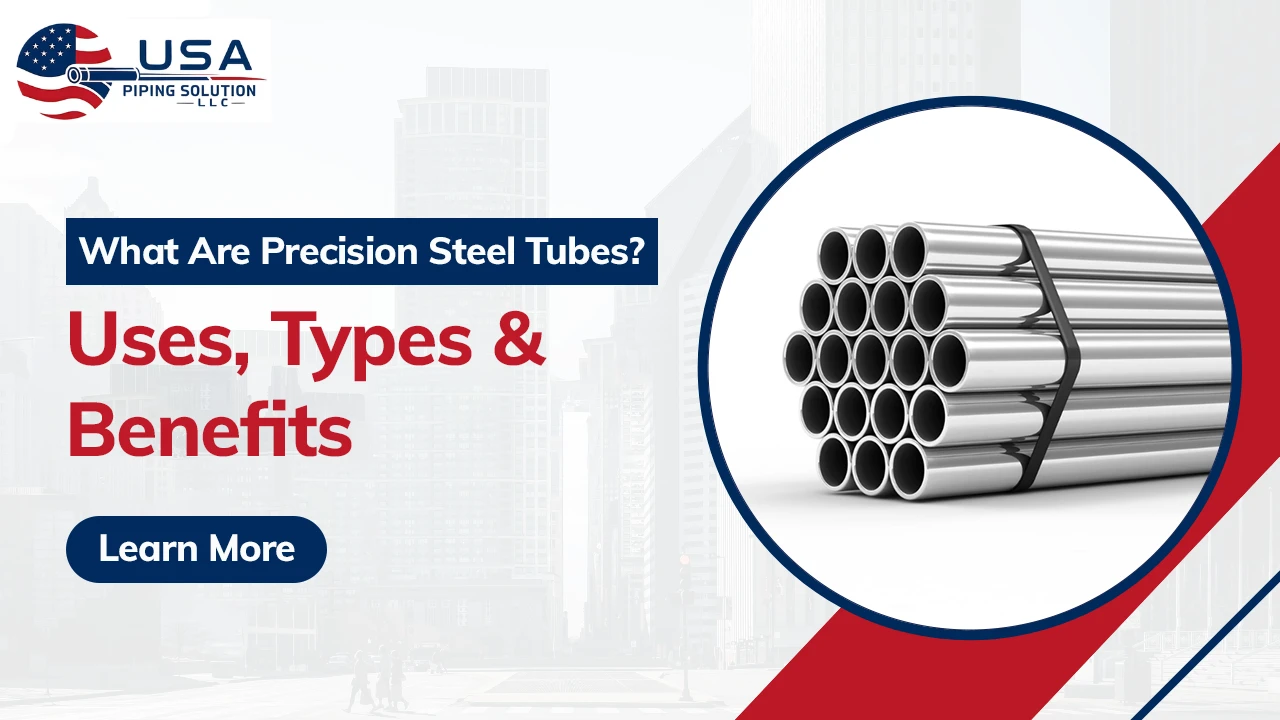
In modern engineering and manufacturing, having components that deliver precise accuracy, top performance and solid reliability is more important than ever. Precision steel tubes are key players here, vital for many different jobs. These aren't just any steel tubes; they're carefully made products, built to meet very strict measurements and smooth finish standards. You'll find them in everything from car engineering and essential hydraulic systems to the detailed parts of special machinery. Precision steel tubes are the quiet workhorses that keep things running smoothly.
At USA Piping Solution, we know how important these parts are. This guide will clearly explain precision steel tubes: what makes them "precision," how they're different from standard pipes, the types available, where they're used in industry and the big advantages they offer. Whether you're an engineer, designer, buyer, or just curious, this article will give you the know-how to understand and pick the best precision steel tube for any tough project. Let's look at why these impressive tubular products are so crucial.
Understanding Precision Steel Tubes
Precision steel tubes are top-quality tubular products made to incredibly tight measurements, much stricter than standard commercial tubes. They're known for their exact dimensions, consistent wall thickness, great centering (concentricity) and smooth finishes. These tubes are a must-have in engineering where accuracy, steady performance and total reliability are critical. Their special qualities come from advanced manufacturing methods and careful quality checks.
What Makes a Tube 'Precision'?
The word "precision" isn't just a label; it means the tube is made to very exact standards. Unlike regular steel tubing, which might be hot-finished or simply welded, precision steel tubes go through extra special steps. These advanced methods, like cold drawing, seamless extrusion then cold finishing, or welding followed by cold drawing/sizing (often called DOM Tubing - Drawn Over Mandrel) are what give them their superior quality. These processes make sure of:
- Uniform Wall Thickness: This is crucial for even strength, handling pressure and acting predictably under stress. Cold drawing helps smooth out tiny variations from the initial tube.
- Excellent Concentricity: This means the inside hole is perfectly centered with the outside diameter. Good concentricity is vital for balanced moving parts and spreading stress evenly.
- Fine Surface Finish (Inside and Out): Smooth surfaces mean less friction, better flow in fluid systems, less wear on parts like seals, and a better surface for coatings.
- High Mechanical Strength & Better Machinability: Cold working, like drawing, makes the material stronger. The consistent structure and tight measurements also make them easier to machine, meaning less tool wear and faster processing.
- Tight Dimensional Tolerances: The outside diameter (OD), inside diameter (ID) and wall thickness are controlled very closely, much more than standard pipes.
Precision Steel Tube vs. Precision Steel Pipe
People often use "tube" and "pipe" as if they're the same, but in engineering and industry, they're different products for different jobs. Knowing this difference is key when you're ordering materials.
|
Feature |
Precision Steel Tubes |
Precision Steel Pipes |
|---|---|---|
|
Main Job |
Structures, machine parts, fluid power, heat exchange |
Moving fluids and gases (carrying volume) |
|
Dimensional Tolerance |
Much tighter (OD, ID, wall thickness carefully controlled) |
Standard industry levels (often by nominal inside size) |
|
Shape |
Round, square, rectangular, custom shapes |
Usually round |
|
How It's Measured |
Exact Outer Diameter (OD) and Wall Thickness (WT) |
Nominal Pipe Size (NPS) and Schedule (wall thickness) |
|
Typical Uses |
Cars, hydraulic/pneumatic systems, machinery, bearings |
Oil & gas lines, water supply, construction, plumbing |
|
Strength-to-weight |
Higher, designed for mechanical work |
Standard, focused on holding pressure and flow |
|
Surface Finish |
Fine, smooth (often ready to use or needs little prep) |
Usually rougher, might need a lot of surface prep |
|
How It's Made |
Cold drawing, advanced welding + cold finishing (DOM) |
Hot rolling, ERW (Electric Resistance Welding) |
|
Price |
Usually costs more due to precision and extra steps |
Cheaper for large volume uses |
Basically, tubes are usually ordered by their exact outer diameter and wall thickness, made for precise jobs where fit and mechanical qualities are most important. Precision steel pipes are generally ordered by a nominal diameter and a schedule number (for wall thickness), mostly for moving fluids or gases. Precision steel tubes take these tube qualities to an even higher level of accuracy.
Types of Precision Tubes Available
Precision steel tubes aren't all the same. They come in different types based on how they're made, the material used, and what they'll be used for, each with its own benefits.
Seamless vs. Welded Precision Tubes
How the tube is made in the first place greatly affects its properties:
- Seamless Precision Tubes:
- How It's Made: Started by piercing a solid steel bar, then pushing or pulling it to the right size, usually followed by cold drawing for precision. There's no welded seam.
-
Benefits: Better at handling pressure because of its even structure, very consistent, strong, and naturally sound. They're less likely to have issues that can sometimes happen along a weld under extreme conditions.
Example Uses: High-pressure hydraulic lines, fuel injection systems, boiler tubes, critical car parts, bearing rings. Common standards include EN 10305-1 (for seamless cold drawn tubes) and ASTM A519. - Welded Precision Tubes (including DOM):
- How It's Made: Formed by rolling steel strips or sheets into a tube shape and then welding the edges, usually with Electric Resistance Welding (ERW). For precision welded tubes, this ERW tube often gets an extra step: cold drawing over a mandrel (DOM). The DOM process fine-tunes the dimensions, improves the surface finish, makes it stronger and makes the weld seam almost invisible.
- Benefits: Often cheaper than seamless tubes for many uses. DOM tubes have excellent centering and consistent walls, are good for bending and shaping and are strong.
- Example Uses: Car frames and parts, shock absorbers, steering columns, support structures, conveyor systems, furniture frames. Common standards include EN 10305-2 (for welded cold drawn tubes) and ASTM A513 (for ERW and DOM mechanical tubing).
|
Type |
Benefit |
Downside (Relatively) |
Example Uses |
|---|---|---|---|
|
Seamless |
Best pressure resistance, naturally consistent |
Usually costs more, might take longer to get |
Hydraulic cylinders, fuel injection, boilers |
|
Welded |
Cheaper, good for bending, excellent OD control |
Weld seam needs attention (though DOM helps a lot) |
Support structures, car parts, conveyors |
Material Composition For Precision Steel Tubes
Choosing the right material is vital and depends on what the application needs in terms of strength, rust resistance, temperature limits and cost.
|
Material Type |
Common Grades/Examples |
Key Qualities |
Typical Applications |
|---|---|---|---|
|
Mild Steel (Low Carbon Steel) |
E235 (EN 10305), ST37.2 (DIN), SAE 1010/1020 |
Easy to shape and weld, cost-effective, lower strength than higher carbon steels |
General engineering, furniture, automotive seating, low-stress structural components |
|
Carbon Steel(Medium to High Carbon) |
E355 (EN 10305), ST52.3 (DIN), SAE 1026, 1045 |
Stronger and harder than mild steel, can be heat-treated, good machinability |
Hydraulic cylinders, axles, shafts, machine parts, heavy-duty structural applications |
|
Alloy Steel (e.g., Chrome-Moly) |
High strength-to-weight ratio, fatigue-resistant, handles heat well |
Aerospace components, racing frames, pressure vessels, high-performance equipment |
|
|
Stainless Steel |
Excellent corrosion resistance, high/low temperature tolerance, hygienic |
Food processing, pharmaceuticals, marine applications, medical and chemical industries |
Each material offers something unique, letting engineers match the tube perfectly to its job and environment.
Applications of Precision Steel Tubes in Industry
Because of its strength, accuracy, and clean finish, precision steel tubes find usage in many different fields. Their assistance of important sectors follows:
- Automotive: The industry with highest consumption of precision steel tubes is that of automobiles. Critical parts requiring dependability, weight-efficiency, and robustness depend on these tubes. Reducing weight while preserving strength helps precision tubes increase vehicle performance and fuel economy.
- Hydraulics & Pneumatics: Operating under high pressure, hydraulic and pneumatic systems call for tubing capable of preserving internal smoothness and tight dimensional tolerances. These tubes guarantee leak-free performance and effective power transfer by their great concentricity and consistent wall thickness.
- Engineering and machinery: General engineering chores involving load-bearing, alignment, or rotational movement depend much on precision steel tubes. Because their uniform outer and inner diameters help to reduce the need for extra processing, these tubes are also favored for precision machining.
- Aerospace: Precision stainless steel tubing's great strength to weight ratio and corrosion resistance find application in the aerospace and defense industries. These tubes have to be exacting standards, and their dependability in hostile conditions makes them absolutely essential in military equipment and aircraft building.
- Medical & Pharma: In the medical and pharmaceutical sectors where hygiene and corrosion resistance are crucial, stainless variations of precision tubes are very vital. Resistance to chemical sterilization, bio-compatibility and cleanliness all of which define precision stainless steel tubing are what appeal here.
- Energy & Power: Precision steel tubes' strength, heat resistance, and pressure tolerance make them indispensable in systems for energy and electricity. In difficult settings including thermal plants, refineries, and nuclear reactors, they guarantee efficiency and safety.
Precision Steel Tubing vs. Precision Stainless Steel Tubing
While both standard carbon/alloy precision steel and precision stainless steel tubing are fundamentally classified as "precision tubes," signifying they are manufactured to exacting dimensional tolerances, specific surface finishes, and consistent mechanical properties, the critical decision in choosing between them mainly depends on a thorough assessment of where it will be used that is, the environmental conditions of the application and what it needs to do, referring to the specific functional requirements and performance expectations. This dependency becomes particularly pronounced and often decisive especially regarding rust and broader corrosion resistance.
Material Composition and Corrosion Resistance
|
Property |
Precision Steel (Carbon/Alloy) |
Precision Stainless Steel |
|---|---|---|
|
Base Material |
Iron-carbon mix (can include Mn, Si, Cr, Mo, etc.) |
Iron-chromium-nickel mix (some grades also have Mo, Ti, Nb) |
|
Corrosion Resistance |
Okay to low (usually needs a protective coat like galvanizing, paint, or oil) |
Excellent (forms a natural, self-healing protective layer) |
|
Typical Grades |
E235, E355, ST52, 1020, 1026, 4130 |
304/304L, 316/316L, 321, Duplex grades |
|
Strength |
Can be very high, especially alloy steels |
Good to very high, gets stronger when worked |
|
Cost |
Generally lower |
Quite a bit higher due to extra metals (Cr, Ni) |
Surface Finish and Cleanliness
Precision Steel (Carbon/Alloy) can reach quite smooth finishes from cold drawing (like bright annealed) regarding surface polish and cleanliness; but, without protection, they can rust. By comparison, Precision Stainless Steel resists tarnish and grime quite effectively and naturally has a better, usually brighter surface finish. This makes it ideal for applications including food and beverage processing, medicine manufacture, medical equipment and tools, and cleanroom regions where hygiene is critical.
Key Benefits of Using Precision Steel Tubes
The careful making and resulting qualities of precision steel tubes offer real industrial benefits that are more than just exact measurements.
- imensional Accuracy and Tolerances:
- Makers can hit tolerances of +/- 0.1 mm (or even tighter for special uses) on outside diameter, inside diameter, and wall thickness.
- What this means: Parts fit together perfectly, less or no extra machining is needed, automated assembly is easier, and parts can be swapped out easily.
- Superior Surface Finish:
- Cold drawing and other finishing steps create smooth surfaces with fine grains.
- What this means: Less friction in moving parts (like hydraulic cylinders), seals last longer, fluids flow better, provides a great base for plating or painting, and they last longer under stress because there are fewer tiny flaws.
- Strength-to-Weight Efficiency:
- Cold working makes the steel stronger. So, a precision tube can often handle the same load with a thinner wall than a standard hot-finished tube.
- What this means: Lighter parts, which is vital in cars and aerospace for fuel saving and performance. It also means using less material, which can help balance out the higher initial cost.
- Easier to Machine and Weld:
- The even grain structure, consistent hardness, and tight measurements of precision tubes mean they machine more predictably and efficiently, with less tool wear and faster production.
- What this means: Lower costs to make finished parts. Certain grades are chosen because they weld well, making strong, reliable joints.
- Consistency and Reliability:
- Tight quality control during manufacturing ensures every tube meets the set standards.
- What this means: You can count on how it will perform, there's less risk of it failing early, and products last longer and are safer.
- Customizability and Cost-Efficiency:
- Precision tubes can often be supplied with:
- Custom cut lengths: Less waste and processing time for you.
- Specific heat treatments: (like annealed for shaping, normalized for even structure, quenched & tempered for high strength).
- Inside and outside surface treatments: (like phosphated for rust resistance and paint grip, oiled for temporary rust protection).
- What this means: Even if the cost per foot is more than standard tubing, you save on machining, waste, assembly problems, and get better performance. This often leads to a lower total cost and makes operations more efficient.
Industry Standards and Certifications:
Precision steel tubes must meet stringent industry standards to ensure uniformity, performance, and safety across applications. Key global standards include the EN 10305 series (EN 10305-1 to EN 10305-6) for seamless and welded cold-drawn tubes used in mechanical, hydraulic, and pneumatic systems. In the U.S., ASTM A513 (for welded/DOM tubing) and ASTM A519 (for seamless mechanical tubing) are widely recognized. German standards like DIN 2391 and DIN 2393/2394 also govern seamless and welded precision tubes, respectively. Manufacturers should be ISO 9001 certified and provide Mill Test Certificates (MTCs) or Certificates of Conformity (CoC) for traceability and material verification. These certifications collectively ensure the precision tubes meet exacting requirements for dimensional accuracy, pressure resistance, and material consistency.
Conclusion
Precision steel tubes are essential components in modern engineering, known for their exact dimensions, high mechanical strength, and smooth surface finishes. Whether it's in hydraulic systems, automotive structures, or industrial machinery, precision steel tubes and precision steel pipes ensure performance, safety, and longevity. By selecting the right material—be it carbon steel, alloy steel, or precision stainless steel tubing—and adhering to recognized standards like EN 10305 or ASTM A519, manufacturers can achieve better quality, lower maintenance costs, and improved efficiency. At USA Piping Solution, we deliver premium precision tubing tailored to your exact requirements, supporting innovation across industries.
FAQs About Precision Steel Tubes :
What are precision steel tubes mainly used for?
Precision steel tubes are used in many jobs needing high accuracy and performance. This includes car parts (fuel lines, shock absorbers, drive shafts), hydraulic and pneumatic cylinders, high-pressure lines, mechanical engineering (bearings, machine parts), aerospace structures, and medical devices.
How are precision tubes different from standard steel pipes?
Precision tubes are made to much tighter size measurements (OD, ID, wall thickness) and usually have a smoother surface. They're designed for mechanical and structural uses where an exact fit and performance are vital. Pipes, on the other hand, are mostly for moving fluids and gases and are ordered by their nominal inside size.
Can I get precision tubes in custom sizes and shapes?
Yes, most makers and expert suppliers like USA Piping Solution can provide precision tubes in custom cut lengths. While round is most common, square, rectangular, and other custom shapes can often be made. OD/ID measurements, surface treatments, or heat treatments can also be customized for your project.
What are the main benefits of seamless precision tubes over welded ones?
Seamless precision tubes are better at handling pressure and have a more even structure because they don't have a weld seam. This makes them great for high-stress jobs and critical fluid systems like hydraulic cylinders. Welded tubes, especially DOM (Drawn Over Mandrel) types, are often cheaper and offer excellent size control and shaping ability for many other uses.
Can standard precision steel tubes (carbon/alloy) resist rust?
Standard carbon or alloy precision steel tubes don't resist rust very well on their own. They usually need protective coatings (like galvanizing, paint, or oil) or need to be used in controlled areas to prevent rust. For jobs needing high rust resistance, precision stainless steel tubes are better because they have a natural protective layer.
What does "DOM" mean for precision tubes?
DOM means "Drawn Over Mandrel." It's a cold working step used on welded tubes. An ERW (Electric Resistance Welded) tube is pulled through a die and over a mandrel. This process refines its dimensions, smooths its surface, makes it stronger, and makes the weld seam almost disappear, resulting in a high-quality precision tube.
